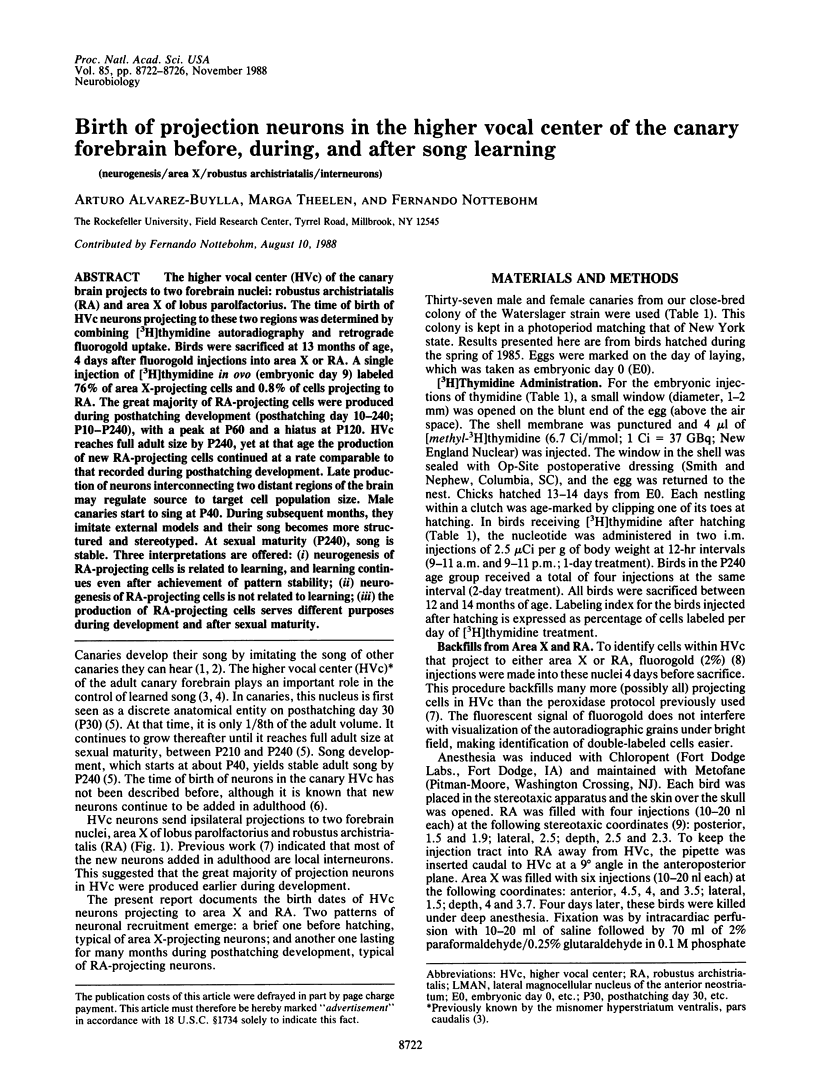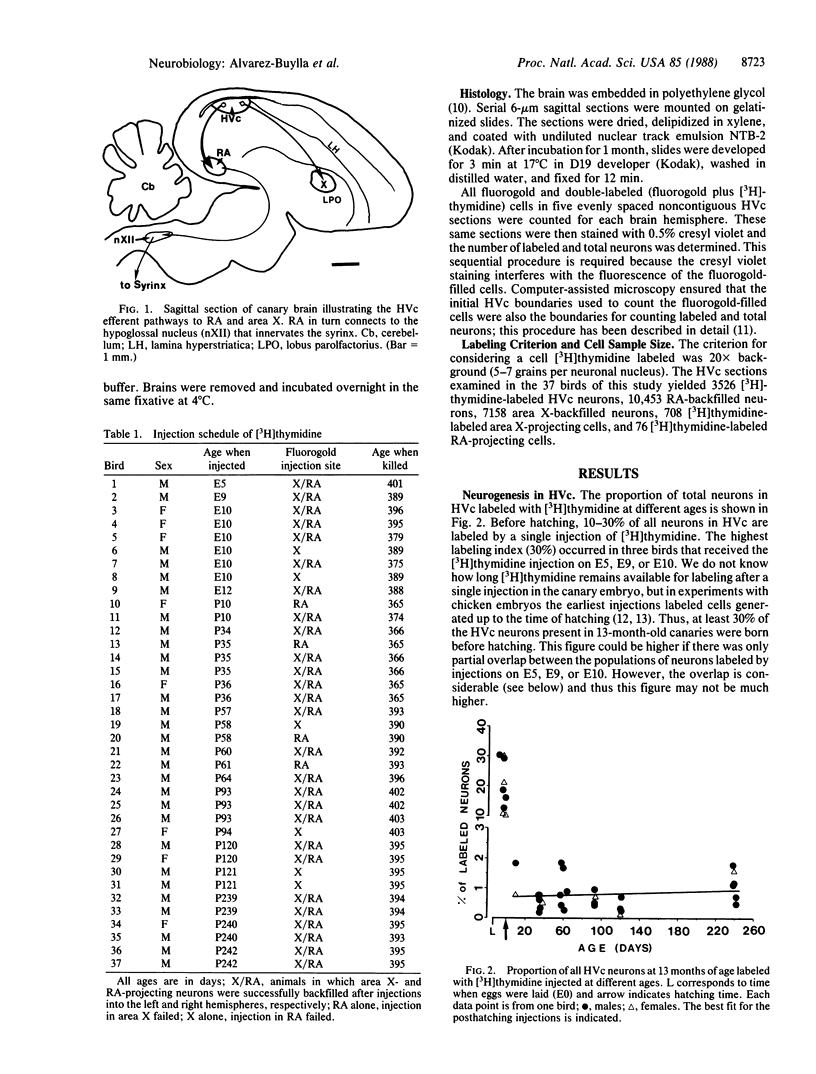Abstract
The higher vocal center (HVc) of the canary brain projects to two forebrain nuclei: robustus archistriatalis (RA) and area X of lobus parolfactorius. The time of birth of HVc neurons projecting to these two regions was determined by combining [3H]thymidine autoradiography and retrograde fluorogold uptake. Birds were sacrificed at 13 months of age, 4 days after fluorogold injections into area X or RA. A single injection of [3H]thymidine in ovo (embryonic day 9) labeled 76% of area X-projecting cells and 0.8% of cells projecting to RA. The great majority of RA-projecting cells were produced during posthatching development (posthatching day 10-240; P10-P240), with a peak at P60 and a hiatus at P120. HVc reaches full adult size by P240, yet at that age the production of new RA-projecting cells continued at a rate comparable to that recorded during posthatching development. Late production of neurons interconnecting two distant regions of the brain may regulate source to target cell population size. Male canaries start to sing at P40. During subsequent months, they imitate external models and their song becomes more structured and stereotyped. At sexual maturity (P240), song is stable. Three interpretations are offered: (i) neurogenesis of RA-projecting cells is related to learning, and learning continues even after achievement of pattern stability; (ii) neurogenesis of RA-projecting cells is not related to learning; (iii) the production of RA-projecting cells serves different purposes during development and after sexual maturity.
Full text
PDF




Images in this article
Selected References
These references are in PubMed. This may not be the complete list of references from this article.
- Alvarez-Buylla A., Buskirk D. R., Nottebohm F. Monoclonal antibody reveals radial glia in adult avian brain. J Comp Neurol. 1987 Oct 8;264(2):159–170. doi: 10.1002/cne.902640203. [DOI] [PubMed] [Google Scholar]
- Alvarez-Buylla A., Nottebohm F. Migration of young neurons in adult avian brain. Nature. 1988 Sep 22;335(6188):353–354. doi: 10.1038/335353a0. [DOI] [PubMed] [Google Scholar]
- Alvarez-Buylla A., Vicario D. S. Simple microcomputer system for mapping tissue sections with the light microscope. J Neurosci Methods. 1988 Sep;25(2):165–173. doi: 10.1016/0165-0270(88)90155-0. [DOI] [PubMed] [Google Scholar]
- Bailey C. H., Chen M. Long-term memory in Aplysia modulates the total number of varicosities of single identified sensory neurons. Proc Natl Acad Sci U S A. 1988 Apr;85(7):2373–2377. doi: 10.1073/pnas.85.7.2373. [DOI] [PMC free article] [PubMed] [Google Scholar]
- Bottjer S. W., Glaessner S. L., Arnold A. P. Ontogeny of brain nuclei controlling song learning and behavior in zebra finches. J Neurosci. 1985 Jun;5(6):1556–1562. doi: 10.1523/JNEUROSCI.05-06-01556.1985. [DOI] [PMC free article] [PubMed] [Google Scholar]
- Bottjer S. W., Miesner E. A., Arnold A. P. Changes in neuronal number, density and size account for increases in volume of song-control nuclei during song development in zebra finches. Neurosci Lett. 1986 Jun 30;67(3):263–268. doi: 10.1016/0304-3940(86)90319-8. [DOI] [PubMed] [Google Scholar]
- Bottjer S. W., Miesner E. A., Arnold A. P. Forebrain lesions disrupt development but not maintenance of song in passerine birds. Science. 1984 May 25;224(4651):901–903. doi: 10.1126/science.6719123. [DOI] [PubMed] [Google Scholar]
- Cowan W. M., Fawcett J. W., O'Leary D. D., Stanfield B. B. Regressive events in neurogenesis. Science. 1984 Sep 21;225(4668):1258–1265. doi: 10.1126/science.6474175. [DOI] [PubMed] [Google Scholar]
- Devoogd T. J., Nixdorf B., Nottebohm F. Synaptogenesis and changes in synaptic morphology related to acquisition of a new behavior. Brain Res. 1985 Mar 11;329(1-2):304–308. doi: 10.1016/0006-8993(85)90539-6. [DOI] [PubMed] [Google Scholar]
- Fifková E., Van Harreveld A. Long-lasting morphological changes in dendritic spines of dentate granular cells following stimulation of the entorhinal area. J Neurocytol. 1977 Apr;6(2):211–230. doi: 10.1007/BF01261506. [DOI] [PubMed] [Google Scholar]
- Goldman S. A., Nottebohm F. Neuronal production, migration, and differentiation in a vocal control nucleus of the adult female canary brain. Proc Natl Acad Sci U S A. 1983 Apr;80(8):2390–2394. doi: 10.1073/pnas.80.8.2390. [DOI] [PMC free article] [PubMed] [Google Scholar]
- Kandel E. R., Schwartz J. H. Molecular biology of learning: modulation of transmitter release. Science. 1982 Oct 29;218(4571):433–443. doi: 10.1126/science.6289442. [DOI] [PubMed] [Google Scholar]
- LaVail J. H., Cowan W. M. The development of the chick optic tectum. II. Autoradiographic studies. Brain Res. 1971 May 21;28(3):421–441. [PubMed] [Google Scholar]
- Margoliash D. Preference for autogenous song by auditory neurons in a song system nucleus of the white-crowned sparrow. J Neurosci. 1986 Jun;6(6):1643–1661. doi: 10.1523/JNEUROSCI.06-06-01643.1986. [DOI] [PMC free article] [PubMed] [Google Scholar]
- Marler P., Waser M. S. Role of auditory feedback in canary song development. J Comp Physiol Psychol. 1977 Feb;91(1):8–16. doi: 10.1037/h0077303. [DOI] [PubMed] [Google Scholar]
- Nordeen K. W., Nordeen E. J. Projection neurons within a vocal motor pathway are born during song learning in zebra finches. Nature. 1988 Jul 14;334(6178):149–151. doi: 10.1038/334149a0. [DOI] [PubMed] [Google Scholar]
- Nottebohm F. Neuronal replacement in adulthood. Ann N Y Acad Sci. 1985;457:143–161. doi: 10.1111/j.1749-6632.1985.tb20803.x. [DOI] [PubMed] [Google Scholar]
- Nottebohm F., Nottebohm M. E., Crane L. Developmental and seasonal changes in canary song and their relation to changes in the anatomy of song-control nuclei. Behav Neural Biol. 1986 Nov;46(3):445–471. doi: 10.1016/s0163-1047(86)90485-1. [DOI] [PubMed] [Google Scholar]
- Nottebohm F., Stokes T. M., Leonard C. M. Central control of song in the canary, Serinus canarius. J Comp Neurol. 1976 Feb 15;165(4):457–486. doi: 10.1002/cne.901650405. [DOI] [PubMed] [Google Scholar]
- Okuhata S., Saito N. Synaptic connections of thalamo-cerebral vocal nuclei of the canary. Brain Res Bull. 1987 Jan;18(1):35–44. doi: 10.1016/0361-9230(87)90031-1. [DOI] [PubMed] [Google Scholar]
- Paton J. A., O'Loughlin B. E., Nottebohm F. Cells born in adult canary forebrain are local interneurons. J Neurosci. 1985 Nov;5(11):3088–3093. doi: 10.1523/JNEUROSCI.05-11-03088.1985. [DOI] [PMC free article] [PubMed] [Google Scholar]
- Rakic P. Specification of cerebral cortical areas. Science. 1988 Jul 8;241(4862):170–176. doi: 10.1126/science.3291116. [DOI] [PubMed] [Google Scholar]
- Schmued L. C., Fallon J. H. Fluoro-Gold: a new fluorescent retrograde axonal tracer with numerous unique properties. Brain Res. 1986 Jul 2;377(1):147–154. doi: 10.1016/0006-8993(86)91199-6. [DOI] [PubMed] [Google Scholar]
- Stokes T. M., Leonard C. M., Nottebohm F. The telencephalon, diencephalon, and mesencephalon of the canary, Serinus canaria, in stereotaxic coordinates. J Comp Neurol. 1974 Aug 1;156(3):337–374. doi: 10.1002/cne.901560305. [DOI] [PubMed] [Google Scholar]
- Tsai H. M., Garber B. B., Larramendi L. M. 3H-thymidine autoradiographic analysis of telencephalic histogenesis in the chick embryo: I. Neuronal birthdates of telencephalic compartments in situ. J Comp Neurol. 1981 May 10;198(2):275–292. doi: 10.1002/cne.901980207. [DOI] [PubMed] [Google Scholar]
- Williams H., Nottebohm F. Auditory responses in avian vocal motor neurons: a motor theory for song perception in birds. Science. 1985 Jul 19;229(4710):279–282. doi: 10.1126/science.4012321. [DOI] [PubMed] [Google Scholar]








